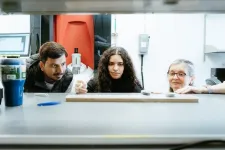New study reveals how RNA travels between cells to control genes across generations
UMD researchers uncover key mechanisms in gene regulation that may lead to better design of RNA-based medicines.
2025-02-05
(Press-News.org) RNA-based medicines are one of the most promising ways to fight human disease, as demonstrated by the recent successes of RNA vaccines and double-stranded RNA (dsRNA) therapies. But while health care providers can now successfully develop drugs that use dsRNA to accurately target and silence disease-causing genes, a major challenge remains: getting these potentially life-saving RNA molecules into cells efficiently.
A new study published in the journal eLife on February 4, 2025, may lead to breakthroughs in RNA-based drug development. University of Maryland researchers used microscopic roundworms as a model to investigate how dsRNA molecules naturally enter cells and influence many future generations. The team discovered multiple pathways for dsRNA to enter the worms’ cells—a finding that could help improve drug delivery methods in humans.
“Our findings challenge previous assumptions about RNA transport,” said the study’s senior author Antony Jose, an associate professor of cell biology and molecular genetics at UMD. “We’ve learned that RNA molecules can carry specific instructions not just between cells but across many generations, which adds a new layer to our current understanding of how inheritance works.”
The team found that a protein called SID-1, which acts as a gatekeeper for the transfer of information using dsRNA, also has a role in regulating genes across generations. When researchers removed the SID-1 protein, they observed that the worms unexpectedly became better at passing changes in gene expression to their offspring. In fact, these changes persisted for over 100 generations—even after SID-1 was restored to the worms.
“Interestingly, you can find proteins similar to SID-1 in other animals including humans,” Jose noted. “Understanding SID-1 and its role has significant implications for human medicine. If we can learn how this protein controls RNA transfer between cells, we could potentially develop better targeted treatments for human diseases and perhaps even control the inheritance of certain disease states.”
The research team also discovered a gene called sdg-1 that helps regulate ‘jumping genes’— DNA sequences that tend to move or copy themselves to different locations on a chromosome. While jumping genes can introduce new genetic variations that may be beneficial, they are more likely to disrupt existing sequences and cause disease. The researchers found that sdg-1 is located within a jumping gene but produces proteins that are used to control jumping genes, creating a self-regulating loop that could prevent unwanted movements and changes.
“It’s fascinating how these cellular mechanisms maintain this delicate balance, like a thermostat keeping a house at just the right temperature so it isn’t too warm or too cold,” Jose explained. “The system needs to be flexible enough to allow some ‘jumping’ activity while preventing excessive movements that could harm the organism.”
Jose believes the team’s findings provide valuable insights into how animals regulate their own genes and maintain stable gene expression across generations. Studying these mechanisms could potentially pave the way for innovative future treatments for heritable diseases in humans.
Looking ahead, the team plans to investigate mechanisms related to the transport of different types of dsRNA, where SID-1 is localized and why certain genes are being regulated across generations while others are not.
“We’re just scratching the surface,” Jose said. “What we discovered is just the beginning of understanding how external RNA can cause heritable changes that last for generations. This work will help scientists better understand how to design and deliver RNA-based medicines to patients more effectively.”
###
The paper, “Intergenerational transport of double-stranded RNA in C. elegans can limit heritable epigenetic changes,” was published in the journal eLife on February 4, 2025.
In addition to senior author Antony Jose and lead author Nathan Shugarts (Ph.D. ’21, biological sciences), other UMD co-authors include biological sciences Ph.D. student Aishwarya Sathya, Andrew L. Yi (B.S. ’19, biological sciences; B.S. ’22, psychology), Winnie M. Chan (B.S. ’19, biological sciences; B.S. ’22, psychology) and Julia A. Marré (B.S. ’09, Ph.D. ’17, biological sciences).
This research was supported by the National Institutes of Health (Award Nos. R01GM111457 and R01GM124356) and the U.S. National Science Foundation (Award No. 2120895). This article does not necessarily reflect the views of these organizations.
END
[Attachments] See images for this press release:

ELSE PRESS RELEASES FROM THIS DATE:
2025-02-05
Women health sector leaders are good for a nation’s wealth, health, innovation, and ethics, among other things, finds a review of the available evidence, published in the open access journal BMJ Global Health.
Yet despite their unique and positive impact, they are a major underused resource, particularly in low and middle income countries, say the researchers, who call for more and sustained investment to maximise women’s potential and reap the benefits of their contribution.
Despite making up 70% of the healthcare workforce, as a whole, and 90% of the nursing ...
2025-02-05
‘Good’ (HDL) cholesterol, usually considered to be beneficial for health, may be linked to a heightened risk of the serious eye condition, glaucoma—at least among the over 55s— suggest the results of a large observational study, published online in the British Journal of Ophthalmology.
Paradoxically, ‘bad’ (LDL) cholesterol, usually regarded as harmful to health, may be associated with a lower risk of glaucoma, a condition that damages the optic nerve, potentially leading to irreversible sight ...
2025-02-05
The GLP-1 drug, exenatide, has no positive impact on the movement, symptoms or brain imaging of people with Parkinson’s, finds a new study led by UCL researchers.
The world’s largest and longest trial of exenatide in people with Parkinson’s disease was funded by the National Institute for Health & Care Research (NIHR) with support for sub-studies from Cure Parkinson’s and Van Andel Institute.
For their research, published in The Lancet, the team designed a randomised controlled phase 3 trial to definitively determine whether exenatide use was associated with any benefit in people with Parkinson’s and ...
2025-02-05
Generally, things really do seem better in the morning, with clear differences in self-reported mental health and wellbeing across the day, suggest the findings of a large study published in the open access journal BMJ Mental Health.
People generally wake up feeling in the best frame of mind in the morning but in the worst around midnight, the findings indicate, with day of the week and season of the year also playing their part.
Mental health and wellbeing are dynamic in nature, and subject to change over both short and extended periods, note the researchers. But relatively few studies have looked at how these might change over the course of the day, and those studies that ...
2025-02-04
“Most people think of juicing as a healthy cleanse, but this study offers a reality check”
CHICAGO --- Think your juice cleanse is making you healthier? A new Northwestern University study suggests it might be doing the opposite. The study, recently published in Nutrients, found that a vegetable and fruit juice-only diet — even for just three days — can trigger shifts in gut and oral bacteria linked to inflammation and cognitive decline.
How was the study conducted?
Northwestern scientists studied three groups of healthy adults. One group consumed only juice, another had juice with whole ...
2025-02-04
URBANA, Ill. – Many U.S. forests are privately owned, particularly in the Eastern and North Central part of the country. This makes control of invasive plants and pests challenging because efforts must be coordinated across landowners. A new study from the University of Illinois Urbana-Champaign explores how differences in ownership motivation affects willingness to control, and how economic incentives can be implemented most efficiently.
“Some own the land for recreational purposes, some own it because they want to produce timber, and some are a combination of both. If one landowner controls invasive species ...
2025-02-04
In many parts of India, a single noxious pollutant from coal-fired power stations drags down annual wheat and rice yields by 10% or more, according to a new study by Stanford Doerr School of Sustainability researchers.
The two grains are critical for food security in India, the second most populous country in the world and home to a quarter of all undernourished people globally.
“We wanted to understand the impact of India’s coal electricity emissions on its agriculture because there might be ...
2025-02-04
The University of Southern California has been approved for $10.8 million in research funding by the Patient-Centered Outcomes Research Institute (PCORI) to compare approaches to treating older adults with a fracture of the hip. Led by principal investigator Joseph Patterson, MD, an orthopaedic surgeon specializing in fracture care at Keck Medicine of USC, the “FASTER-Hip” trial aims to determine whether patients with a certain type of hip fracture fare better with a hip replacement or a simpler surgery known as internal fixation.
The trial leadership team includes ...
2025-02-04
CLEVELAND -- University Hospitals Cleveland Medical Center is one of the most recognizable hospitals among doctors in the U.S. and around the world, according to an annual survey.
UH Cleveland Medical Center was ranked eighth in the U.S. and 16th globally in a survey of the strongest Academic Medical Center brands, according to Brand Finance, a London-based brand valuation consultancy.
“This ranking is a reflection of all we do at University Hospitals to provide compassionate care for patients, work to find the next generation of therapies and treatments, invest ...
2025-02-04
Rice University physicist Emilia Morosan is part of an international research collaboration that has been awarded multimillion-dollar funding from The Kavli Foundation to develop and test next-generation superconductors through artificial intelligence and quantum geometry. This global initiative, spearheaded by Päivi Törmä of Aalto University in Finland, seeks to push the boundaries of quantum materials science and superconductivity.
The project includes funding from the Klaus ...
LAST 30 PRESS RELEASES:
[Press-News.org] New study reveals how RNA travels between cells to control genes across generations
UMD researchers uncover key mechanisms in gene regulation that may lead to better design of RNA-based medicines.



